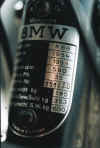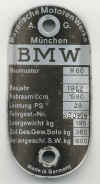BMW Airhead motorcycle model, year, and VIN errors
VIN means what?
The legal description of a vehicle is often defined as the Vehicle Identification Number or VIN. When you hear someone say VIN number, that is redundant, repetitive, tautologous, and pleonastic 🙂 In other words, if you say “VIN number,” you sound stupid.
In the prewar days, most models didn’t have matching numbers on the frame and engine. After the war, they matched until about 1980, and then again didn’t match.
In California, 40 years ago, a model was whatever year the dealer said it was. Commonly a dealer had an “old” one and lied on the title to make it appear to be what he had told the customer. I have seen this happen with a 3-year error. One customer bought a 1974 R90/6 in 78 as a 77. Boy, he was mad when he found out about the lie.
In the USA, a vehicle is not known by the start of production. Every brand of vehicle production is around Sept of the previous year. The first four months of production are known as the next year. In Europe, a vehicle year is that of the date of production. For example, the manufacture of the first /5 started in the last few months of 1969. Those bikes were titled 1969. However, the ones produced in those months are known as 1970 bikes in the USA.
A BMW that was imported from Europe may show that contradiction. If first titled in Europe and privately imported into the US, the title will show 1969. The term for a German title is “brief.” If the brief is turned in at the DMV, it will show 1969. I never once submitted a brief for the dozens of antique BMWs I imported. I would copy the page with the necessary information and turn that in. I always kept the brief with the bike.
We have seen the California DMV transfer ownership and mess it up by 20 years. I have seen several BMWs that didn’t even exist. That is, the VIN wasn’t in any number system. I have seen BMW mis-stamp the VIN with an extra digit or skip a digit. I have even seen them overstamp it, and it looked “stolen.”
I owned a model that didn’t “exist.” By the post-WWII occupation forces, the Germans weren’t allowed to produce anything larger than 250cc. They needed money, so they collected bits from the war rubble to make and sell them “under the table.” It is a sports version of the military 750 cc engine.
I would trust the stamped frame number before a title. One can change engines all day long in California without changing the title. Not so with the frame, as the title must be modified. If your title is correct, consider it an accident. I am not implying that a government agency could make a mistake 🙂
If a new engine was purchased out of the parts book as a spare part, it came with no serial number stamped into the case. Different countries had different procedures for documenting a replacement engine, so it was left unstamped.
Samples of a BMW motorcycle VIN
This photo is an example of the engine number of a /2. It is located on the right side of the engine and just above the cylinder. This photo shows the cylinder removed. Look at the BMW logo stamp on each side of the 6-digit number. I believe you should find that stamp on any factory engine from 1950 to 1970. If an owner had installed an engine as a spare part, it would come with that same place completely blank. Since 56, BMW has used only that font for the /2. If you see a different font, no logo, or anything suspicious, I suggest that you be very careful.
This photo is an example of the engine number of a /5. See the factory logo only at the end of the 7-digit number? The /6 also has the logo at the end of the serial numbers.
The VIN is in the lower right, 1/3 of the photo.
Here it is, close up. See the logo at the end of the 7-digit string? It is the same on the /6 and maybe later too.
This is the VIN on an R51/3 engine. The engine is the same as the /2, but the VIN is on the left side, not the right side. See both BMW logos stamped in? Photo courtesy of Darryl Richman. Thanks.
See the VIN on the frame of the same R51/3? It is on the left side of the bike and on the casting that holds the rear plunger spring. The thick paint is covering up the two BMW logos. This shows the location of the post-war bikes until the very last of the /3 production. Then the frame number was moved up to the side of the steering head.
This photo shows the removable aluminum VIN plate (BMW frame plate) that is attached to the steering head. It came on every BMW until the /5, which has a paper/plastic one. This plate is from the sports model, the R68. The photo was “lifted” from the German R68 site. Thanks. The number on the plate has no legal standing. Authorities need to see the stamped VIN with the BMW logo on each side.
A superb example of a plate. Photo provided by Duncan Lloyd. Thanks.
For an explanation of 1980 and later, go to snowbum’s site.
For a list of VINs, by model, go to this site.
Click here for information on the BMW logo, or emblem.
Do you want to know the date that your BMW was built? Send an email with the VIN to Andreas.Harz@partner.bmw.de and politely ask for information. He is a very nice man.
Updated 30 March 2023








